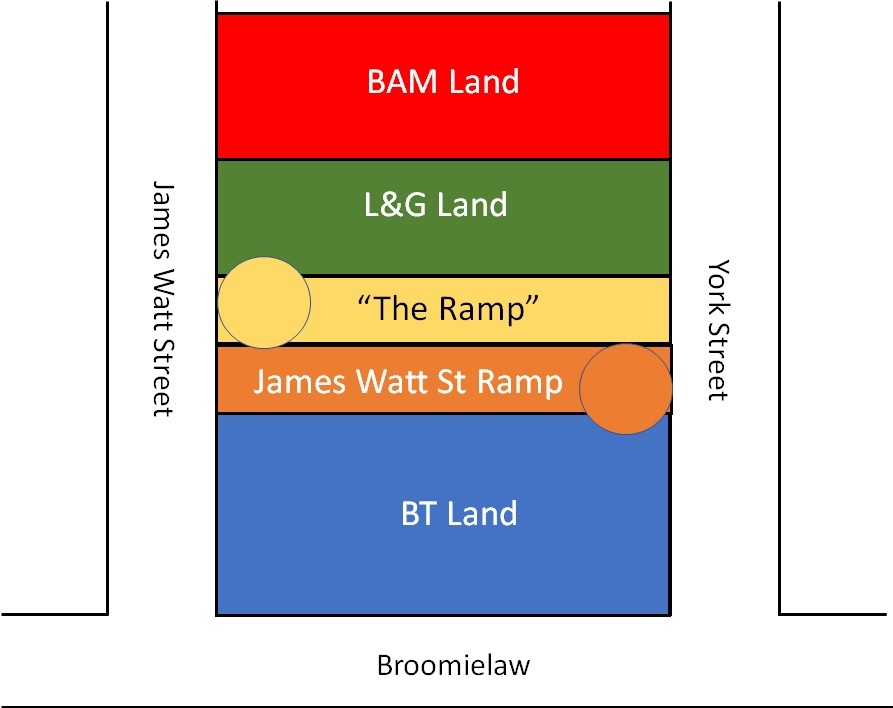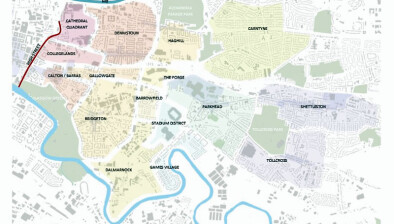John Macleod: Common problems – BAM TCP Atlantic Square Limited v BT plc
Dr John Macleod of Edinburgh Law School examines inaccuracy and the offside goals rule in light of a recent case in the Outer House.

The Atlantic Square development
BAM TCP Atlantic Square Limited v BT plc [2020] CSOH 57 presents something approaching a full house of recent hot topics in conveyancing: interpretation of a deed of conditions; determination of the scope of common property; the transitional provisions in the Land Registration etc (Scotland) Act 2012; positive prescription and the offside goals rule. Lady Wolffe is therefore to be congratulated for managing to get through everything in a mere 95 paragraphs. The focus of this blog, however, is the interaction between inaccuracy as understood under the 1979 and 2012 Act, and the offside goals rule.
At its heart, the dispute was reasonably straightforward: it concerned the ownership of a strip of land between neighbouring properties and is an example of how much easier conveyancing cases would be for the reader if freer use were made of diagrams. With that in mind, a rather crude one has been attempted here.

The disputed land was an access ramp (referred to as “the Ramp” throughout the judgment) which lies between James Watt Street and York Street in Glasgow. The pursuer (BAM TCP Atlantic Square Limited) sought declarator that it was the sole owner of the Ramp. BT plc contended that it owned a one-half pro indiviso share in it.
The plots owned by the pursuer, by Legal & General Pensions Ltd, by BT and the two ramps shown in the diagram were all once part of a site owned under a single title by Pardev (Broomielaw) Ltd. In June 1997, Pardev registered a deed of conditions which (on Lady Wolffe’s interpretation, paragraph 43) defined “Common Parts” in a manner which included the ramps and indicated an intention that they would be owned pro indiviso by the plot owners. Plans were appended to the deed of conditions which illustrated that the ramps were part of the common parts of the site. Rightly, there was no suggestion that registration of the deed of conditions had dispositive effect. However, the disposition to BT (registered in July 1997) gave a bounding description of the BT Land and then included the following words “together with (1) the whole rights, common, mutual and exclusive pertaining thereto as specified in the Deed of Conditions granted by us in respect inter alia of the subjects hereby disponed”. This reference was repeated in the property section of BT’s title sheet.
The BAM Land was first transferred by Pardev in October 1999 and acquired by the pursuer in April 2002. The plan in the pursuer’s title sheet indicated that both the BAM Land and the ramps where owned by the pursuer. The burdens section included the Pardev deed of conditions, including the definitions which suggested that the ramps were to be owned in common.
Interpreting the titles
What then, did Lady Wolffe make of the titles? Was there a conflict between them and, if so, how was that conflict to be resolved?
First, she found that the 1997 disposition to BT had conveyed a pro indiviso right in the ramps. The pursuer’s argument that such a right could not be included because the ramps were outside the area described by the bounding description of the BT Land and (consequently) outside the area delineated in red on both the plans appended to the disposition and in the title sheet was rejected.
Lady Wolffe found that the words “together with (1) the whole rights, common, mutual and exclusive pertaining thereto as specified in the Deed of Conditions …” were sufficient to carry the pro indiviso share. In doing so, she rejected the pursuer’s suggestion that “pertaining thereto” restricted what the clause would carry to rights relating to property within the red boundary.
She gave (at paragraphs 54–55) a helpful account of the interpretation of the term “pertinent” as used in Scottish conveyancing sources. This showed that that term frequently refers to rights beyond the boundaries of the principal subjects conveyed.
In light of this, the Keeper should have reflected the pro indiviso right in the title sheet. The question of whether the right was in fact reflected on the title sheet was crucial because, under section 3(1) of the Land Registration (Scotland) Act 1979, title flowed from the register. BT’s right was not mapped on the title plan. However, Lady Wolffe considered the reference to the “rights specified in” the deed of conditions and to its supplementary plans in the property section of BT’s title sheet, together with the deed of conditions’ inclusion in the burdens section of title sheet as sufficient. Thus, after registration of BT’s disposition, BT had a pro indiviso right in the Ramp.
The description and plan on the pursuer’s title sheet, on the other hand, included the ramps and made no direct reference to the right to the ramps being merely a pro indiviso share. The title plan did have an annotation referring to supplementary plans which were the same as those appended to the deed of conditions and the terms of the deed of conditions were included in the burdens section. Lady Wolffe held (at paragraphs 70 and 71) that, since BT’s right to the ramp was conferred by the disposition to BT rather than by the deed of conditions, mere reference to the material from the deed of conditions did not mean that the pursuer’s title sheet presented it as only having a pro indiviso share. The title sheets thus clashed.















